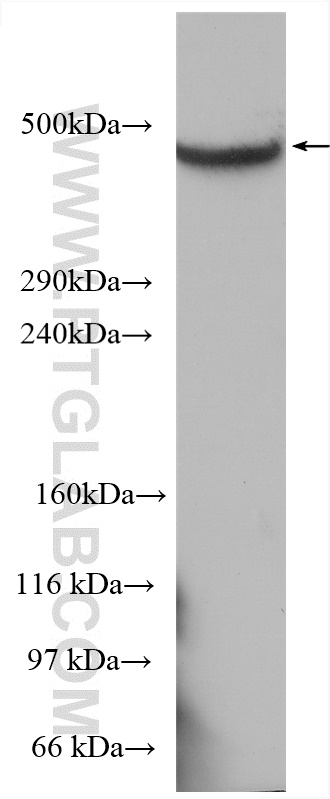验证数据展示
经过测试的应用
| Positive WB detected in | COLO 320 cells |
推荐稀释比
| 应用 | 推荐稀释比 |
|---|---|
| Western Blot (WB) | WB : 1:500-1:2000 |
| It is recommended that this reagent should be titrated in each testing system to obtain optimal results. | |
| Sample-dependent, Check data in validation data gallery. | |
发表文章中的应用
| WB | See 1 publications below |
产品信息
19675-1-AP targets HSPG2-Specific in WB, ELISA applications and shows reactivity with human, mouse, rat samples.
| 经测试应用 | WB, ELISA Application Description |
| 文献引用应用 | WB |
| 经测试反应性 | human, mouse, rat |
| 文献引用反应性 | human |
| 免疫原 | Peptide 种属同源性预测 |
| 宿主/亚型 | Rabbit / IgG |
| 抗体类别 | Polyclonal |
| 产品类型 | Antibody |
| 全称 | heparan sulfate proteoglycan 2 |
| 别名 | HSPG2, LG3 peptide, HSPG, heparan sulfate proteoglycan 2, Endorepellin |
| 计算分子量 | 469 kDa |
| 观测分子量 | 469 kDa |
| GenBank蛋白编号 | NM_005529 |
| 基因名称 | HSPG2 |
| Gene ID (NCBI) | 3339 |
| RRID | AB_10638605 |
| 偶联类型 | Unconjugated |
| 形式 | Liquid |
| 纯化方式 | Antigen affinity purification |
| UNIPROT ID | P98160 |
| 储存缓冲液 | PBS with 0.02% sodium azide and 50% glycerol , pH 7.3 |
| 储存条件 | Store at -20°C. Stable for one year after shipment. Aliquoting is unnecessary for -20oC storage. |
背景介绍
HSPG2, also named as PLC and HSPG, is an integral component of basement membranes. It is responsible for the fixed negative electrostatic charge and is involved in the charge-selective ultrafiltration properties. It serves as an attachment substrate for cells. Defects in HSPG2 are the cause of Schwartz-Jampel syndrome (SJS1). Defects in HSPG2 are the cause of dyssegmental dysplasia Silverman-Handmaker type (DDSH). The antibody is specific to HSPG2.
实验方案
| Product Specific Protocols | |
|---|---|
| WB protocol for HSPG2-Specific antibody 19675-1-AP | Download protocol |
| Standard Protocols | |
|---|---|
| Click here to view our Standard Protocols |
发表文章
| Species | Application | Title |
|---|---|---|
Int J Biol Sci Exosomal Transfer of Vasorin Expressed in Hepatocellular Carcinoma Cells Promotes Migration of Human Umbilical Vein Endothelial Cells. | ||
Nat Commun An adeno-associated virus variant enabling efficient ocular-directed gene delivery across species |
